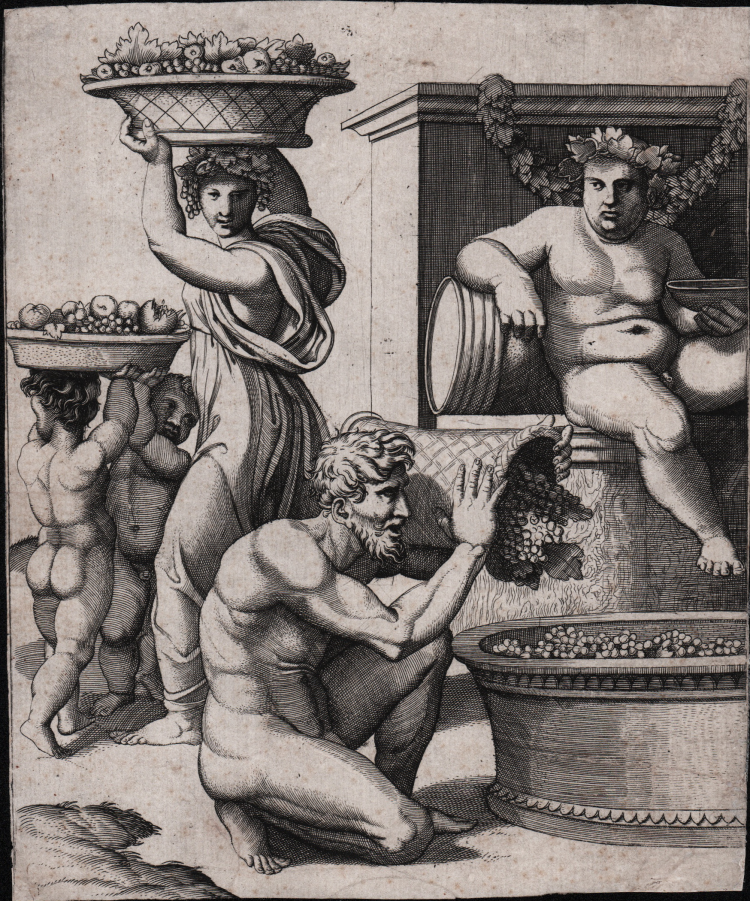




| Reference: | S35379 |
| Author | Scuola di Marcantonio Raimondi |
| Year: | 1520 |
| Measures: | 146 x 178 mm |



| Reference: | S35379 |
| Author | Scuola di Marcantonio Raimondi |
| Year: | 1520 |
| Measures: | 146 x 178 mm |
Engraving, 1520 circa, not dated or signed. First state ante litteram, of three.
A very good impression, printed on contemporary laid paper, in very good condition.
Anonimous copy, in the same direction, after Marcantonio Raimondi engraving.
The engravings shows the harvesting of grapes, presided over by a thoughtful Silenus, cup in hand, accompanied by four harvesters who perform the festive ritual in powerful, exemplary postures.
The Raimondi engraving is probably after a drawing attributed to Giovanni Francesco Penni, today in the possession of Leo Steinberg, see Shoemaker no. 38a.
According to Shoemaker, Marcantonio Raimondi altered the drawing in a Raphaelesque manner and gave the image more weight and impact. Almost each detail can be associated with antique Bacchic sarcophagi, but no individual source has been identified. As the composition is also connected with Raphael's works, the print (like the Judgement of Paris, Bartsch XIV.197.245) shall be regarded as a Raphaelesque transformation of ancient sources.
|
Bartsch XIV.231.306 (as after Raphael); TIB, 17, p. 226; Passavant VI.30.186; Delaborde 1888, no. 136; Shoemaker 1981, no. 38; Raphael Invenit, p. 247, no. VI.2 (only state)
|
Scuola di Marcantonio Raimondi
|
Marcantonio Raimondi is considered the greatest engraver of early Renaissance and the first to spread the work of Raphael. He was born in San’Andrea in Argine, near Bologna. His first artistic apprenticeship took place in Bologna, around 1504, in the workshop of Francesco Francia, painter and goldsmith.
His first known engraving is dated 1505. In 1506 he went to Venice to live and work; in this year, he started developing his own personal style for, in his production that period, is quite evident the influence of Mantegna and Dürer. According to Vasari, Raimondi met Dürer in Venice, for they were both living there at the same time, but they had a quarrel over the reproductions, on copper, of Dürer’s seventeen woodcuts of the Vita della Vergine. After 1507, he turned to different models, especially those coming from Rome and Florence. He was in Rome in 1509, where he was introduced into the circle of the most important artists working in the City, such as Jacopo Rimanda from Bologna. In the same year he met Rapahel in the workshop of Baviera; the following year Raimondi became popular as the main interpreter of Raphael’s paintings. The Lucrezia can be considered the starting point of their cooperation and a sort of second beginning for Raimondi’s new style. In any case, together with the engravings representing Raphael’s works, Raimondi went on with the publication of his own subjects, especially antiquity, whose influence can be seen in his whole production (cfr. Dubois-Reymond 1978).
Between 1515-1516 Marcantonio started showing a keen interest for chiaroscuro, maybe under the influence fo Agostino Veneziano and Marco Dente, from Baviera’s workshop.
Till Raphael’s death, in 1520, Raimondi worked and lived in the background of the great artist from Urbino and engraved his works and those of his scholars.
His business went down after the Sacco (sack) Di Roma in 1527, when he was obliged to pay a huge amount of money to the invaders of the City to save his life.
He died in Bologna before 1534, in complete misery.
|
|
Bartsch XIV.231.306 (as after Raphael); TIB, 17, p. 226; Passavant VI.30.186; Delaborde 1888, no. 136; Shoemaker 1981, no. 38; Raphael Invenit, p. 247, no. VI.2 (only state)
|
Scuola di Marcantonio Raimondi
|
Marcantonio Raimondi is considered the greatest engraver of early Renaissance and the first to spread the work of Raphael. He was born in San’Andrea in Argine, near Bologna. His first artistic apprenticeship took place in Bologna, around 1504, in the workshop of Francesco Francia, painter and goldsmith.
His first known engraving is dated 1505. In 1506 he went to Venice to live and work; in this year, he started developing his own personal style for, in his production that period, is quite evident the influence of Mantegna and Dürer. According to Vasari, Raimondi met Dürer in Venice, for they were both living there at the same time, but they had a quarrel over the reproductions, on copper, of Dürer’s seventeen woodcuts of the Vita della Vergine. After 1507, he turned to different models, especially those coming from Rome and Florence. He was in Rome in 1509, where he was introduced into the circle of the most important artists working in the City, such as Jacopo Rimanda from Bologna. In the same year he met Rapahel in the workshop of Baviera; the following year Raimondi became popular as the main interpreter of Raphael’s paintings. The Lucrezia can be considered the starting point of their cooperation and a sort of second beginning for Raimondi’s new style. In any case, together with the engravings representing Raphael’s works, Raimondi went on with the publication of his own subjects, especially antiquity, whose influence can be seen in his whole production (cfr. Dubois-Reymond 1978).
Between 1515-1516 Marcantonio started showing a keen interest for chiaroscuro, maybe under the influence fo Agostino Veneziano and Marco Dente, from Baviera’s workshop.
Till Raphael’s death, in 1520, Raimondi worked and lived in the background of the great artist from Urbino and engraved his works and those of his scholars.
His business went down after the Sacco (sack) Di Roma in 1527, when he was obliged to pay a huge amount of money to the invaders of the City to save his life.
He died in Bologna before 1534, in complete misery.
|